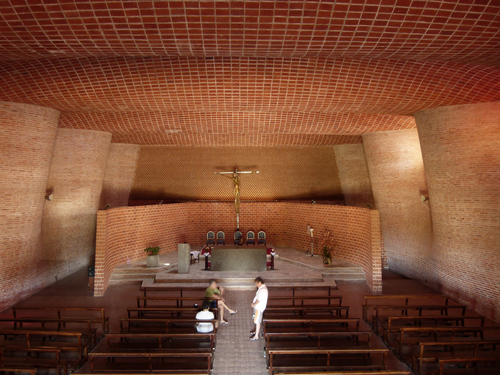Eladio Dieste is a famous Uguarian Architect and Engineer born in 1917, he was one of the most significant characters in the period of modernization in Latin America. His works normally consist structural experiments that pursue extreme challenge on traditional materials. Besides that, he is especially fascinated by brick construction.
The Church of Christ Obrero, is remarkably but truly Eladio Dieste’s first architectural project. In this project the engineer ginius introduced two innovative construction methods to build brick structure: "Gaussian Vaults" and “ruled walls”. Accordingly, both systems consist double curved masonry surfaces which are formed to increase stiffness under corresponding forces.
Dieste's constructions system created a brand new way of creating masonry structures, including an adjustable scaffolding that could be reused and build repetitive brick vaults, and a building method to insert reinforcement in the parts where tension force is expected to occur. His system brought new opportunities for this local construction method, while saving materials through a highly efficient structural form.
Modernism in its early stage, was tightly connected to the industrilization of European region. As other nations around the world were gradually developed into industrialized countries, the new technology of construction also spread rapidly into far continents. It is difficult to claim the regional authenticity while the new technology easily overwhelms traditional construction methods. For example, reinforced concrete is such a material that was considered the perfect replacement for almost all building materials that have been applied. Including timber, brick, stone and steel.
Eladio Dieste is such an architect that stood for the battle for the material traditions; he persisted on this trial to explore how materials are utilized in a much longer history and how to transform those techniques from the past into new artifice. His experiments may be judged as a sustainable act in today’s perspective, because this experimental approach to design with traditional materials reveals a strong notion of localized construction. Talking about the relationship between technology and society, Dieste's approach to technology has provided stronger consciousness in relation to the local context. By that, technical innovation is made more acceptable and perceptible by the local community. More importantly, his works created a type of new identity which could never be achieved with simply imported technology. Although Dieste's projects stood only with low profile in the modern history, his design methodology which let ideas grow from the place did leave a lot of inspiring messages for future architects.
WikiArquitectura. (n.d.). Cristo Obrero Church. Retrieved from Open Buildings: http://openbuildings.com/buildings/cristo-obrero-church-profile-41935?_show_description=1
Anderson, S. (2004). Eladio Dieste : Innovation in structural art. . New York: Princeton Architectural Press.
